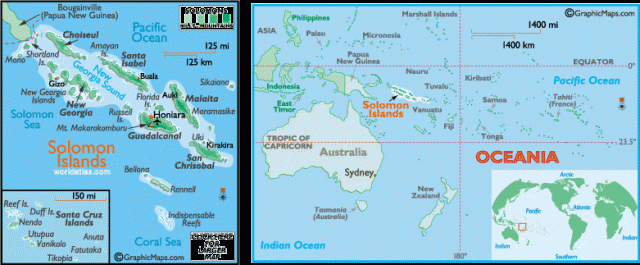Solomon Islands
Area 10,985 square mi (28,450 square km)
Population 572,200 2014
Capital Honiara
Highest Point 8,028 ft (2,447 m)
Lowest Point 0 m
GDP $1.158 billion 2014
Primary Natural Resources fish, forest products, gold, bauxite.
THE SOLOMON ISLANDS form an archipelago lying east of PAPUA NEW GUINEA, between the Solomon Sea and the South PACIFIC OCEAN. The country is composed of 992 islands and atolls, approximately one-third of which are inhabited. The principal islands of the chain are Choiseul, New Georgia, Malaita, Santa Isabel, Makira, and Guadalcanal, where the capital Honiara is located. These larger islands feature rugged mountainous terrain covered with dense tropical rainforests.

Several of the islands show evidence of human occupation since 6500 B.C.E. Natural vegetation, marine life, and subsistence agriculture in the coastal areas have supported a sparse population since 4000 B.C.E., and westward migration by Polynesians dates from 1600 C.E. Spanish explorers began visiting the archipelago in the late 16th century. Western penetration was limited by the intense hostility of native inhabitants, as well as by the almost impenetrable jungle terrain.
Nonetheless, during the mid-19th century the Solomon Islands were a source of laborers for European colonies in Oceania and AUSTRALIA. Through a process known as “blackbirding,” male youths were kidnapped and taken abroad under long-term labor contracts to work under harsh conditions in mines and on commercial plantations. The practice was halted around the time that GERMANY and Britain advanced claims to the islands of the archipelago in the 1890s. Germany's possessions in the northern Solomons, except the large island of Bougainville, were traded to Britain, and by 1900 most of the contemporary Solomon Islands formed a British protectorate.
During World War I, Bougainville and other islands remaining under German control were occupied by Allied troops, and afterward AUSTRALIA administered the Solomons. During World War II, JAPAN occupied most of the islands, and American forces fought to eject them, producing some of the Pacific War's most intense fighting. Australia and Britain shared postwar responsibility for the islands, with some of Australia's charges becoming independent in 1975 as part of Papua New Guinea. Britain also introduced self-government, and the British Solomons gained full independence in 1978.
With consistent year-round temperatures and tropical rainfall, the Solomon Islands feature tremendous biodiversity. Over 4,500 plant species have been identified, as well as a wide variety of insects, fish, mammals, and birds. Extensive mangrove swamps support specialized marine and bird life.
Although mountainous areas make up over 85 percent of the country's land area, a thriving timber industry aimed at European, American, and Australasian export markets has deforested some 10 percent of the country. Soil erosion, water pollution, and damage to the islands' coral reefs have become major environmental problems. Mining activities on certain islands also contribute to soil erosion and create waste disposal problems.
Melanesians make up over 90 percent of the population, with small numbers of Polynesians, Chinese, and Eurasians composing the remainder of the Islands' full-time residents. Active missionary efforts dating from the mid-19th century have resulted in widespread acceptance of Christianity.